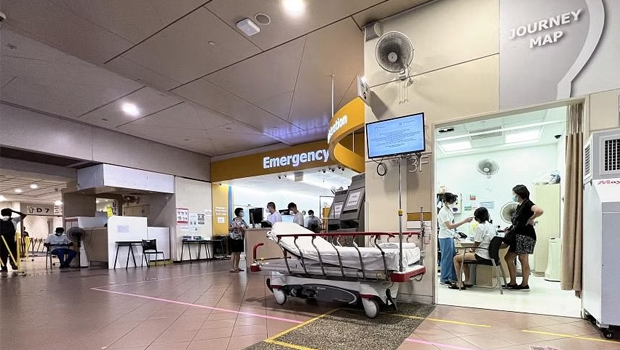
The AI model predicts whether a patient is at higher risk of death based on their vital signs and medical history. ST PHOTO: ALPHONSUS CHERN
SINGAPORE – A predictive model that can flag patients at risk of death, as well as those who are safe for discharge, has been developed to aid healthcare professionals in sorting emergency department (ED) patients more accurately according to the severity of their conditions.
Currently, assessing and sorting patients is performed by a triage nurse, who will ask about the patient’s condition and assess their vital signs before assigning a Patient Acuity Category (PAC) Scale.
PAC 1 is the most severe and requires resuscitation, while PAC 4 is the least severe and often a non-emergency.
But it can be difficult to gauge the risk of death accurately based on the triage nurse’s initial assessment, which could also vary depending on the nurse’s experience, said Ms Yvonne Wong, lead author of the project and a third-year medical student at Duke-NUS Medical School.
To help tackle this, the team led by Duke-NUS developed an artificial intelligence (AI) model known as PAC+ that uses data from more than 300,000 ED patients from 2016 to 2018 to predict whether a patient is at higher risk of death, based on their vital signs and medical history.
“They may generally look well, but if their risk of death is high based on the AI, then the clinician may reassess – should they actually be triaged to a higher priority level and be seen within a shorter period of time?” Ms Wong said.
PAC+ is one of nearly 220 project abstracts submitted for Singapore General Hospital’s (SGH) Annual Scientific Meeting awards in 2024. The two-day meeting held at the SGH Campus will end on April 13.
The PAC+ team hopes that their model can also help identify patients who are suitable for Mobile Inpatient Care at Home (MIC@Home), a programme that provides hospital-level care to patients in their homes.
Senior Minister of State for Health Janil Puthucheary, who was guest of honour at the Annual Scientific Meeting, said the advent of AI presents new opportunities for using digital technology to derive more accurate, efficient and timely treatments.
With initiatives to ensure the safe implementation of AI services in the healthcare industry, such as the development of guidelines in 2021, Dr Janil said it is hoped that AI can be safely adopted to complement the healthcare workforce.
For instance, it could reduce the administrative workload, freeing front-line healthcare workers to focus on face-to-face conversations and develop “stronger therapeutic alliances” with their patients, he said.
In another project, a team led by SGH pharmacists developed a method that can halve the time needed to test which antibiotic works best against a specific kind of bacteria, allowing patients to receive treatment in a more timely fashion.
Currently, it takes at least two days to determine the best antibiotic to use against a bacterial infection – with at least one day needed to culture the bacteria in a patient’s blood sample and another or several days to test which antibiotic stops its growth.
But bacterial infections are a ticking time bomb.
“Bacteria multiplies every 20 minutes,” said Associate Professor Andrea Kwa from Duke-NUS Medical School, who is also deputy director (research and innovation) at SGH’s Department of Pharmacy and senior author of the project.
If the right type of antibiotics is not given early, the patient may die before the results are ready, she added.
This is where the new method comes in. The team’s method takes just four to six hours to find out which antibiotics are most effective, allowing treatment to be given to a patient more speedily.
Lead author of the project, Dr Yeo Jia Hao, said the method involves staining the bacteria with fluorescent dyes and exposing it to different antibiotics for about an hour.

Dr Yeo Jia Hao said the method involves staining the bacteria with fluorescent dyes and exposing it to different antibiotics for about an hour. PHOTO: SGH
After the bacteria is stained, it undergoes flow cytometry, a precise technique that can detect and measure the fluorescence shown by the cells.
It can also pick up small numbers of bacteria that are potentially resistant to antibiotics, something current methods are unable to do.
Flow cytometry will show less fluorescence in this small subpopulation of bacteria that is resistant, in contrast to the majority of the bacteria in the sample.
Dr Yeo said: “Because flow cytometry measures every single cell, you can actually pick up really small subpopulations that don’t usually get picked up by current methods. So this is a very strong technique.”
The more stressed the bacteria is by the antibiotics, the more brightly they will be lit. The degree of brightness can be quantified, measuring the effectiveness of the antibiotics.
Keep Healthy With
© 2025 SingHealth Group. All Rights Reserved.



















